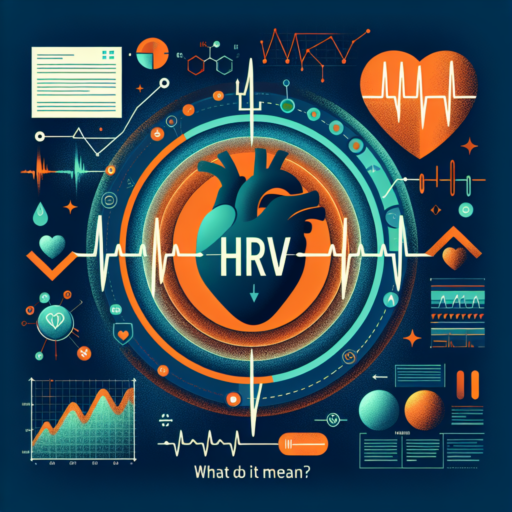Understanding HRV: An Introduction
Heart Rate Variability, or HRV, is increasingly becoming a key metric for assessing overall health and fitness levels. At its core, HRV measures the variation in time between each heartbeat, which is controlled by the autonomic nervous system. Unlike the heart rate itself which provides a snapshot at a certain moment, HRV offers a dynamic and nuanced view of the body’s physiological state and resilience.
The significance of HRV lies in its ability to signal the body’s readiness to perform and its stress levels. A higher HRV indicates a healthy, responsive system capable of adapting to stress and performing optimally. Conversely, a lower HRV points to stress, fatigue, or potential underlying health issues. By monitoring HRV, individuals can make informed decisions about training, recovery, and lifestyle adjustments to enhance their well-being.
Understanding your own HRV can begin with simple practices. Utilizing HRV monitoring tools and apps enables individuals to track their daily HRV scores. This data, when consistently collected, can reveal patterns and insights about the body’s response to various stressors and rest periods. Recognizing these patterns allows for more personalized and effective health and fitness strategies.
How HRV Reflects Your Health and Wellness
Understanding the intricate relationship between Heart Rate Variability (HRV) and overall health and wellness is essential in today’s fast-paced world. HRV measures the variation in time intervals between heartbeats, serving as a critical biomarker for autonomic nervous system function. This variability indicates the balance between the sympathetic and parasympathetic branches, portraying a comprehensive snapshot of our body’s resilience and adaptability to stress.
High HRV is often associated with a robust cardiovascular system and a well-functioning autonomic nervous system, signaling good health and high levels of fitness. Conversely, low HRV may suggest stress, fatigue, or underlying health issues. It’s a nuanced indicator, allowing individuals to monitor their wellness and make informed decisions about their lifestyle, diet, and exercise regimes.
Key Benefits of Monitoring HRV for Health
- Improved understanding of stress levels and recovery status
- Enhanced ability to forecast fatigue and prevent overtraining
- Guidance for personalized lifestyle and wellness decisions
By paying attention to changes in HRV, one can gain insights into their physical and emotional well-being. This valuable data aids in tailoring personal health strategies, ensuring a well-rounded approach to health and wellness that aligns with the body’s needs.
The Science Behind HRV: What Does It Mean for Your Body?
Heart Rate Variability (HRV) is an essential indicator of the autonomic nervous system’s function and, consequently, a window into the overall well-being of your body. In essence, HRV measures the variation in time between each heartbeat, which, contrary to what one might think, should not be entirely uniform. A higher variability suggests a healthy, responsive cardiovascular system, capable of efficiently adapting to stress, both physical and emotional.
At the heart of HRV’s importance lies its ability to offer insights into the balance between the sympathetic and parasythetic branches of the autonomic nervous system. The former prepares your body for ‘fight or flight’ responses, while the latter supports ‘rest and digest’ activities. An optimal HRV reflects a harmonious dance between these two systems, indicating resilience, stress management capability, and even longevity. Research has shown that changes in HRV can be predictive of various health outcomes, making it a valuable tool for monitoring stress and recovery status.
Moreover, advancements in technology have made HRV tracking more accessible to the everyday person. Through wearable devices and mobile applications, individuals can now monitor their HRV and gain actionable insights into their health and fitness levels. This democratization of HRV data empowers people to make informed decisions about training intensity, recovery needs, and lifestyle modifications to promote cardiovascular health and stress resilience.
HRV: Decoding the Language of Your Heart
Understanding your heart’s messages goes beyond just feeling its beats; it involves delving into the nuanced language of Heart Rate Variability (HRV). This invaluable metric offers a window into the autonomic nervous system, reflecting how stress, relaxation, and various emotional states influence your heart. By decoding HRV, we gain insights into our body’s inner conversations, where each fluctuation has a tale to tell about our wellbeing.
At its core, HRV represents the variation in time intervals between consecutive heartbeats. Unlike the constant rhythm often associated with a healthy heart, a higher HRV indicates a robust and adaptable cardiovascular system, ready to efficiently navigate the daily stresses life throws our way. Empowering individuals with the knowledge of their own HRV patterns, therefore, becomes a powerful tool in managing stress, enhancing performance, and promoting a heart-healthy lifestyle.
Technological advancements have made monitoring HRH getenvurther accessible through wearable tech and smartphone applications, putting this once complex health metric at the fingertips of anyone curious about their heart health. Analyzing these patterns, individuals can tailor their lifestyle, fitness routines, and relaxation practices to optimize their HRV, thus fostering a deeper connection with their heart’s health.
Improving Your Health with HRV: Practical Tips and Techniques
Heart Rate Variability (HRV) measures the variation in the time interval between heartbeats, and understanding your HRV can be a game-changer for your health and fitness regime. With the right practical tips and techniques, you can leverage HRV to improve your overall wellness significantly. Here, we will delve into some effective strategies that can help you get the most out of your heart’s health.
Monitor Your HRV Regularly
Consistent monitoring of your HRV provides invaluable insights into your body’s response to various stressors, both physical and emotional. By using HRV tracking devices and apps, you can identify patterns and understand what activities boost or hinder your wellbeing. This data empowers you to make informed decisions that promote heart health and resilience against stress.
Integrate Breathwork into Your Routine
One of the simplest yet most powerful techniques to improve your HRV is through focused breathing exercises. Breathwork, such as deep belly breathing and the 4-7-8 technique, can enhance your vagal tone, a key component in boosting your HRV. Implementing just a few minutes of breathwork daily can lead to significant improvements in your HRV scores and, consequently, your health.
Balance Physical Activity and Rest
Finding the right balance between exercise and rest is crucial for optimizing HRV. High-intensity interval training (HIIT) can improve HRV by enhancing cardiovascular efficiency, but adequate rest and recovery are equally important. Incorporate a mix of strenuous exercises and restorative activities like yoga to maintain a healthy HRV balance. Remember, overtraining can be as detrimental to your HRV as a sedentary lifestyle.
The Role of Technology in Monitoring HRV
In today’s digital age, technology plays a pivotal role in various aspects of health and fitness, notably in the monitoring of Heart Rate Variability (HRV). HRV measures the time variation between heartbeats and is a critical indicator of an individual’s cardiovascular health and autonomic nervous system balance. The advancement of technology has significantly improved the accessibility and accuracy of HRV monitoring, offering insights that were once exclusive to medical professionals.
Wearable Technology: One of the most significant breakthroughs in the field of HRV monitoring is the development of wearable technology. Devices such as smartwatches and fitness trackers now come equipped with sensors capable of measuring HRV. This accessibility allows individuals to track their HRV in real-time, providing a comprehensive overview of their stress levels, recovery status, and overall well-being. Such devices have transformed HRV monitoring from a clinical procedure to a convenient, everyday practice.
Mobile Applications: Accompanying the rise of wearable technology, mobile applications dedicated to HRV monitoring have become increasingly popular. These apps not only display HRV data collected by wearables but also offer detailed analyses and personalized recommendations. Users can now easily interpret their HRV measurements, understand their body’s signals, and make informed decisions about their health, fitness routines, and stress management strategies. The integration of technology in this manner democratisizes health information, making it accessible to everyone, irrespective of their medical knowledge.
HRV and Stress Management: What You Need to Know
Understanding the link between Heart Rate Variability (HRV) and stress management is essential for anyone looking to enhance their well-being and resilience to stress. HRV, a measure of the variation in time between each heartbeat, is directly linked to our body’s autonomic nervous system (ANS) and its ability to regulate stress levels. Essentially, a higher HRV indicates a healthier balance between the sympathetic and parasympathetic nervous systems, showcasing an individual’s capacity to manage stress efficiently.
Monitoring HRV for Better Stress Management: By keeping a close eye on your HRV, you can get valuable insights into how your body responds to stress and relaxation. This information is crucial because it enables individuals to adopt lifestyle changes, make informed decisions about their health, and implement effective stress management techniques. Various studies suggest that regular monitoring and adjustments based on HRV readings can significantly improve overall stress resilience and emotional well-being.
The relationship between HRV and stress management is not just about measurement; it’s about action. Engaging in regular physical activity, practicing mindfulness, and ensuring a balanced diet are all proven strategies to enhance HRV and, as a result, improve stress management. By incorporating these practices into your daily life, you can actively influence your HRV for the better, leading to a more balanced, stress-resistant lifestyle.
Comparing HRV Levels: What Is Considered a Good Score?
Understanding the concept of Heart Rate Variability (HRV) is crucial for anyone aiming to improve their physical fitness or monitor their stress levels. HRV refers to the variation in time between successive heartbeats, and it’s regarded as a significant indicator of the autonomic nervous system’s flexibility and overall heart health. But when it comes to comparing HRV levels, knowing what constitutes a «good» score is essential for effective health management.
Generally, a higher HRV is considered a good sign, indicating greater variability between heartbeats and, thus, higher cardiovascular system adaptability. This can imply better stress resilience, recovery capacity, and overall wellbeing. However, the optimal HRV score can vary significantly based on age, gender, and physical condition. For instance, trained athletes often exhibit higher HRV scores compared to non-athletes, highlighting the impact of regular, intense physical activity on heart rate variability.
Key Factors Influencing HRV Scores
- Age: HRV typically declines with age, making age-specific benchmarks necessary for accurate comparison.
- Physical Fitness: Individuals with higher levels of physical fitness usually enjoy higher HRV scores.
- Stress Levels: Exposure to stress, both psychological and physical, can significantly lower HRV.
To accurately determine what a «good» HRV score is for you, it’s important to consider personal attributes and lifestyle factors. Continuous monitoring over time, rather than single measurements, provides the most insightful comparisons. This approach reveals personal trends and the impact of lifestyle adjustments, making the interpretation of HRV scores more meaningful in the pursuit of health and wellbeing.
No se han encontrado productos.
HRV Trends and Research: What the Future Holds
The landscape of Heart Rate Variability (HRV) is continuously evolving, offering a fascinating glimpse into the future of health and wellness monitoring. As research deepens and technology advances, the trends emerging in the field of HRV are promising a revolution in how we understand and manage our physiological well-being. One of the most notable trends is the increasing integration of HRV data into consumer wearable devices, which signals a shift towards more personalized and preventative healthcare approaches.
Personalized Health Insights Through HRV
With the advent of sophisticated algorithms and machine learning, HRV analysis is becoming more refined, paving the way for highly personalized health insights. This trend reflects a broader shift in healthcare towards more tailored treatments and monitoring. By leveraging detailed HRV data, individuals and healthcare providers can pinpoint stress levels, monitor recovery, and even predict potential health issues before they become serious, marking a significant step forward in preventive health care.
Advances in HRV Research and Applications
Research into HRV is uncovering its potential applications in various fields, from sports science to mental health. Sports professionals are using HR to optimize training regimens, ensuring athletes achieve peak performance without overtraining. Meanwhile, in the realm of mental health, HRV is becoming a valuable tool for monitoring stress and emotional states, offering new avenues for managing conditions such as anxiety and depression. As research continues to advance, the potential applications of HRV are expanding, underscoring its value beyond traditional health metrics.
The integration of HRV data with artificial intelligence (AI) is another burgeoning trend, promising to unlock even deeper insights into health and wellness. By analyzing vast datasets, AI can discern patterns and correlations that may elude human observers, offering unprecedented precision in health monitoring and management. As we look to the future, it is clear that HRV will play a pivotal role in shaping the next generation of health technology, offering rich opportunities for innovation and improvement in how we care for our wellbeing.




